Panevezys (Ponevezh)
Lithuania
Written by Joseph Rosin
English edited by Fania
Hilelson-Jivotovsky
Ponevezh (Panevezys in Lithuanian) lies on both banks of the Nevezhis (Nevezys) River in central northern Lithuania.
Settlers began to settle on the right bank of the river at the beginning of the sixteenth century, and it was there that the Old City developed. Later the city expanded to the left bank, and the New City was built, becoming the center of the Upyte County.
The nearby village Upyte (15 km away) was the administrative center of the area for hundreds of years. In those years, until the beginning of the eighteenth century, the Nevezys River played an important role allowing ships to sail up river to Ponevezh.
In 1661 the "Old City" was granted permission to arrange two market days per week and two big market-fairs per year. During the seventeenth century and at the beginning of the eighteenth century the city endured invasions of the Swedes. In 1704 the Swedish Army passed through the city, looting the area.
At the end of the eighteenth century, the landlord of the town, Prince Nikolai Tishkewitz cut down the forest, which divided the town in two. Ponevezh became one united town and the center of the Upyte district.
After the third division of Poland in 1795 by the three superpowers of the time-Russia, Prussia and Austria, this part of Lithuania including Ponevezh was handed over to Russia. During the Russian rule (1795-1915) Ponevezh was annexed into Vilna Gubernia (province) in 1802, and from 1843-into the Kovno Gubernia. Since then the district acquired the name the Ponivezh district.
During the Polish rebellions in 1831 and 1863 the city suffered damages, and the rebels hanged a number innocent Jews.
After the rebellions were crushed, Russification politics increased, and Russians who agreed to settle in the city enjoyed great privileges.
The construction of the railway Dvinsk (Daugavpils)-Ponivezh-Radvilishok (Radviliskis) in 1873 connecting the main rail to Prussia and the construction of the narrow railway from Ponivezh to Utian (Utena) and Shventzian (Svencionys) promoted development of the city. A few factories were built contributing to growth of commerce and trade.
By the middle of the nineteenth century until World War I the population in the city doubled. (5,908 people in 1857, 12,968-in 1797)
In the years 1915-1918 Ponevezh was under German occupation. During the period of Independent Lithuania (1918-1940) Ponevezh was a district center. The city grew and developed becoming the fourth largest city of Lithuania.
The Jewish Settlement till after World War I
The Karaites
A Karaite settlement existed in Ponevezh on the right bank of the river started at the end of the fourteenth century, long before Jews started to settle there. The Lithuanian Great Duke Vytautas brought 483 Karaite families to Lithuania from the Crimea. These families were captured in the war, and 153 families were settled in Ponevezh. Other families settled in Trakai, which later became the center of the Karaites in Lithuania. The Karaite settlement in Ponevezh was mentioned in the customs lists of 1697/98.
During the Polish rule and at the beginning of the Russian rule the Karaites were treated as Jews despite their different language and customs. In 1863 the Russian rule granted them full civil rights. The subsequent years they gradually kept away from the Jews; they intermarried and their community disintegrated. During the period of Independent Lithuania only a few dozen Karaite families lived in Ponevezh on the street next to their Synagogue. In 1932 there were 100 Karaites in town. In 1935 the local Karaites were visited by the "Chacham" (Rabbi) from Trakai.
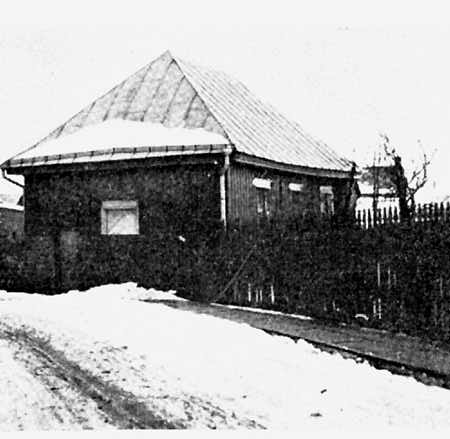
The Karaite Synagogue
The relations between the Karaites and the Jews were generally not bad. In 1827 serious disagreements between them was caused by the pressure to send recruits to the Russian Army.
The leaders of the Karaites in Ponevezh in the eighteenth century were Avraham Kaplonovsky and Avraham ben Mordechai.
Society and Economy
Jews started to settle in Ponevezh on the left bank of the river, apparently, at the beginning of the eighteenth century. In 1766 there were 254 Jews in town who paid a " per head tax".
They built their homes around the Market Square and in the adjacent area. They developed trade in flour, yeast and flax production and engaged in skilled occupations and small industries and their numbers began to grow fast.
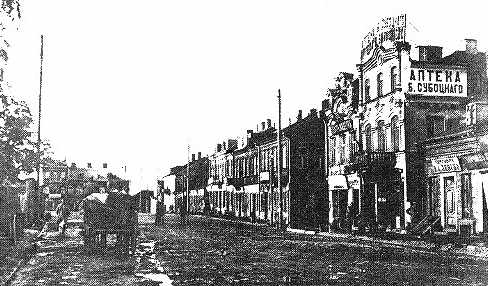
The Market Square (1914)
In 1847 there were 1,447 Jews in Ponevezh; in 1857 - 3,566 (60% of the population); in 1864 - 3,648 including 70 Karaites (45% of the population); in 1884 there were 15,030 inhabitants in town and among them 7,899 Jews (52%); in 1897 - 6,627 (51% of 13,044 total population).
Most of the Jews were shopkeepers and merchants, but there were also many in skilled occupations such as carpenters, leather workers, milliners, glove makers, saddle makers, tinsmiths, glaziers, knitters, oven builders, watchmakers, dressmakers, laundry washers, porters, cart owners and other workers, who waited every day at the street corner for an employer. There were also men who were employed in seasonal work such as guarding fields in summer or baking Matzot before Pesach.
In 1887 a printing house owned by N.Feigenzon opened in Ponevezh, and remained in business for long years.
In 1841 there were 18 shoemakers and 16 tailors among other skilled workers in Ponevezh. At the end of the nineteenth century there were local Jews who leased cattle from Christian farms and produced milk and cheese. There were also different "Religious Officers", Jewish doctors, lawyers, dentists, pharmacists and teachers. Most of them leaned towards assimilation and were adopting the Russian culture. There was also a minority who were close to Jewish affairs; several of them were supporters of the "Bund" (the anti-Zionist workers organization) and others were supporters of the Socialist Zionism.
The main Jewish suburb of this period was the "Slabodka" built in a swampy area where most of the poor lived. Jewish houses built in wood would burn down from time to time in the big fires.
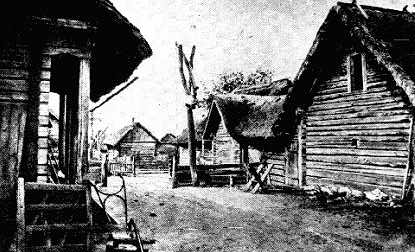
Wooden Houses in the Suburb (1914)
From the period between 1750 and 1796 the town burned down seven times. Fires were also registered in the second half of the nineteenth century. In 1861 almost all Jewish houses burned down including the "Beith-Midrash". More affluent Polish farmers in the vicinity helped the victims of the fire (Kudrevitz, Bushinsky, Gruzevsky and others).
In May 1881 more than half of the town burned down. Eight streets with stores, warehouses filled with goods, three Synagogues with rare books - all went up in flames. 2,000 people remained without shelter. The same year in August another fire broke out, and the properties of fifteen families burned. In October 1882 fifty houses and twenty-five stores filled with goods went up in flames.
In April 1883 another fire broke out and forty houses where 150 families lived and fifteen shops burned down. About 800 people were left destitute - without clothes and without food.
After every fire desperate calls for help were included in the Hebrew newspaper "haMeilitz" issued in St.Petersburg. The donations had to be sent to the Rabbi of the city Eliyahu-David Rabinovitz. Significant help for the victims was rendered by the "Charity Fund" of Memel headed by Rabbi Dr.Yitshak Rilf.
In spring 1888 moving ice blocks destroyed the bridge over the Nevezys River. A local man built a ferry, which collapsed one day, and all the passengers fell into the water. Three men drowned and among them the rich philanthropist, one of the builders of the Jewish Hospital -Yisrael Kisin and the other, a young man, 35 years old, Zvi-Hirsh Shayevitz.
In 1883 the Russian Authorities did not permit Jews to live in the villages of Ponevezh district. About 400 families in the area were forced to move to Ponevezh to other Jewish homes which were crowded already due to above-mentioned fires.
All this had an impact on the economic situation of the Jews. Almost half of them were very poor. In those years, at the beginning of the 1880s, many Jews from Ponevezh immigrated to South Africa. A strong "Association of Former Ponevezh Jews" was active in that country for many years.
Education and Culture
Jewish children were educated mostly in the "Cheder" and in "Talmud-Torah". In 1893 hundreds of poor children studied in the Ponevezh Talmud-Torah. Many of them received a daily meal at one of the homes of the richer families in town.
During all these years general education schools were also open for Jewish children in Ponevezh. In 1853 a government-sponsored school was founded where the well known Hebrew poet Y.L.Gordon taught. After his departure from Ponevezh, the teacher Yitshak Romash founded a private school for girls in 1861 where Russian, German, French, Hebrew, arithmetic and embroidery were taught. There was also an elementary school for boys. In 1878 this school closed and an elementary school for Jewish boys opened in its place. In addition to general subjects, Hebrew grammar, the history of the Jewish people, introduction to Jewish religion and some important prayers with Russian translation were taught. Sixty boys, most of them very poor, studied in the school. In 1859 the Government as the inspector of the schools in Ponevezh appointed a local Jew, P. Stern.
In 1886 a group of educated young men from rich families (Libshtein, Troib, Dembo, Berman, Grosman, Segal, Levnshtein, and Drakin) initiated regular fund raising activities to help the poor children in town. The talented children were sent to study Torah and Wisdom while the others were offered to work as apprentices in skilled occupations.
Before the Polish Rebellion in 1863 there were no restrictions against the registration of Jewish boys at the Russian high school in town. Several outlawed socialist circles and revolutionists engaged in underground activities acted in it and eventually gave rise to the "Bund." After the rebellion Jewish children were forbidden to study in this high school and they had to commute to other towns. In 1889 twenty-nine Jewish children among 289 pupils (10%) studied in the high school in Ponevezh At the teachers' seminar 164 female students were registered, among them 14 Jewish girls (8.5%).
In 1868 the educated elite opened a library in Ponevezh, ignoring the opposition of the fanatic religious circles. In 1900 a young writer opened an advanced school for Hebrew studies and after several months he had 32 students coming from the more affluent families in town. The "Melamdim" became envious and informed the police that he was spreading the socialism theory. After his apartment was searched no charges were filed against him.
In 1910 a number of Jewish educational institutions were opened in Ponevezh. Among them there was the School for Boys with two classes offering a program for vocational skills, a Talmud-Torah and, a private school for girls. The School for Boys consisting of two classes, the Talmud-Torah and the vocational class were able to remain open due to the support of the philanthropist Tsemach Broido. The Talmud-Torah elected Tsemach Broido, David Kisin, Meir Gurion, Shalom Landoi, and Yitshak Dembo to their board in 1891
Many learned men were active in Ponevezh, among them the Hebrew poet Y. L. Gordon, who was a teacher in the government-sponsored school during the years 1853-1860, J. Sirkin; J. Romash and others who struggled to provide education for Jewish youth and fought hard against religious fanaticism in town.
Religion and Welfare
The religious life of Ponevezh Jews centered around the ten Synagogues and the "Beth-Midrash". In addition there were tens of "Minyanim", "Shtiblach" and "Kloisim" for different trades people. At the "Shulhoif" (the yard of the Synagogues) there were five prayer houses, among them the old wooden Synagogue that was built apparently in the eighteenth century. It had a magnificent "Aron Kodesh" and "Bima" and a very special big copper candelabrum. This yard had the "Glikeles Klois" and the "Beth- Midrash" with its famous "Sun Clock" (see below).
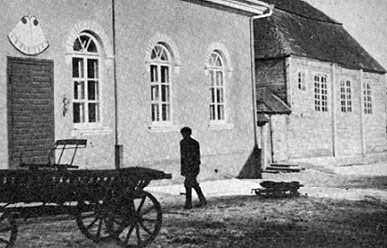
The "Beth-Midrash" with its Sun
Clock
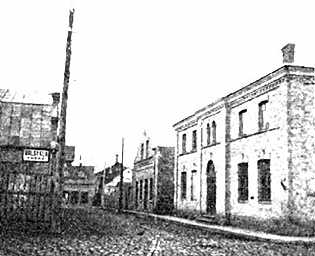
The Synagogue of the "Tehilim"
Society
In 1912 the Yeshiva called "Ponivezh Kibbutz" was founded by Rabbi Yitshak-Ya'akov Rabinovitz (Itsele Ponivezher) supported by the Gavronsky family from Moscow. A special building was built nearby "Glikeles Klois" which accepted only twenty of the most talented men. They received a monthly scholarship from the widow of B.Gavronsky, the daughter of the tea magnate Klonimus-Zeev Wisotsky (born in Old-Zhager, Lithuania, 1824-1904) hence the institution was independent of public support. Even when the 'Kibbutz" together with all Ponevezh Jews was exiled to Russia in 1915, the students continued to receive their scholarship.
After the Bolshevik revolution in 1917 the "Kibbutz" was dispersed. In 1919 Rabbi Itsele returned to Lithuania, but after a short time he died of typhus. The "Kibbutz" existed for seven years, and many well known Rabbis in the Jewish world had been trained as its students.
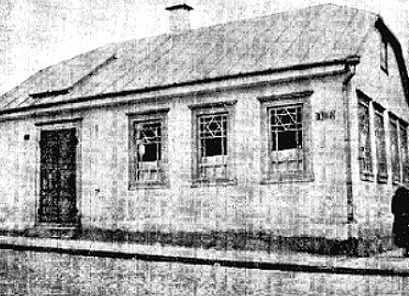
The Great Synagogue
Among the Rabbis who served in Ponevezh there was Avraham-Abele Yofe (died in 1820), Shaul Shapira (served in Ponevezh 1839-1853), Moshe-Yitshak Segal (died in 1870), Hillel Mileikovsky (died in 1899), a student of Israel Salanter, who was one of the spiritual leaders of the Russian Jewry for fifty years, Eliyahu-David Rabinovitz-Teomim (served in Ponevezh 1871-1891). The above mentioned Yitshak-Ya'akov Rabinovitz, was the head of the "Yeshiva" of Slobodka in Kovno (1889-1894) and the Rabbi of Ponevezh (from 1896 till his death in 1919). Among the rabbis was also Chayim Chveidansky (during World War I), Moshe-Yitshak Rabin who was the head of the "Yeshiva" and a "Dayan" for forty years (a religious judge, died in 1902), also Avraham-Eliyahu Pumpiansky (1835-1893) was the Official (state) Rabbi in town for twelve years (1860-1872).
Almost all of these Rabbis published books or booklets dealing with religious issues.
In 1886 the Jewish Hospital in Ponevezh opened in a magnificient and spacious building in a beautiful park. The hospital was built outside the town on a plot that was purchased by the wealthy leaders of the community (M.Z. Kisin; J.Tsemachovitz and others) for 10,000 rubels, an enormous sum in those days.
In 1893 a pharmacy serving the hospital and providing free medication for the poor opened next door. On "Purim" 1888 a big benefit for the hospital was organized where the popular poet Elyakum Tsunzer read his poems.
The members of the executive of the hospital were A. Dembo, J. Berlin, M. Shidersky, J. Sapir and Advocate D. Zakheim.
In Ponevezh "Moshav-Zkeinim" (Old Age) opened where dozens of old men and women lived.
The welfare institutions in town were: "Bikur Cholim"(care for the sick), "Linath haTsedek" (since 1898), "Chevra Kadisha" (in charge of the burials), a Women Society that cared for the old and the orphans, "Hachnasath Orchim" where each poor guest received lodging for three days and six meals, "Hachnasath Kala" (care for poor brides), "Somech Noflim" since 1890, which provided loans not exceeding 100 rubels without interest, to small shopkeepers.
In 1887 a Kosher Kitchen (Ma'achal Kasher) was established for the Jewish soldiers who served in the local garrison of the Russian Army.
In the summer of 1894 a cholera epidemic hit the town. A special "Help Committee" was organized which spent 1,500 rubels on poor patients. There was also a free kitchen distributing meals for 150 poor people no matter what their faith. The meals included bread, meat and a side dish. This Committee worked only three months existing on the donations provided by the philanthropists of the town .
On two lists of contributors for victims of hunger in different Lithuanian towns in 1871 and 1872 names of Ponevezh Jews appear. The treasurer was Ze'ev Volfson.
Zionist and Other Activities
Jews from Ponevezh immigrated to Eretz-Yisrael yet before the "Chibath Zion" (Fans of Zion) movement was organized. In the old cemetery of Jerusalem there are at least fifteen headstones of Ponevezh Jews, buried during the 1850s and (see Appendix I).
In 1867 a few Ponevezh Jews organized a group with the aim of immigrating to Eretz-Yisrael, following news that American Christians were settling in the Land. But only after twenty years they managed to reach their goal when together with a group from Bialistok they renewed the settlement of Petach-Tikva previously abandoned due to a deadly epidemic of Malaria.
In the autumn of 1883 six families from Ponevezh immigrated to Eretz-Yisrael and settled on land bought near Jaffa. Among the Ponevezh Jews immigrating to Eretz-Yisrael before World War I were Dov Leibovitz who joined the "Bylu"im (Beth Ya'akov Lechu veNelcha), Yehuda-Munish Idelovitz who made "Aliyah" in 1873 and consequently earned a living engraving inscriptions on tombstones, Eliezer-Elchanan Shalit who arrived in 1882, settled in Rishon-leZion becoming the first Jew who cultivated olive trees in the land; Rabbi Eliyahu-David Rabinovitz-Teomim, who arrived in 1905 and was elected as the Chief Rabbi of the Ashkenazi Community in Jerusalem; Chayim-Moshe Fein with his family who was among the first settlers in Metula. Professor Gideon Mer (1894-1961) arrived in 1913 and became the adjutant of Joseph Trumpeldor in "The Mule Driver Regiment" of the British Army in WW I. He established and ran the Malaria Research Laboratory in Rosh-Pina and was the Chief Doctor of the Palmach (the attack troops of the Haganah) and the head of the Preventative Medicine in IDF (Israel Defence Forces). He later became the deputy of the Director General of the Health Ministry of the State of Israel.
At the Regional Conference of the Russian Zionists which took place in Vilna in 1899 one of the two delegates from Ponevezh was Rabbi Yitshak-Ya'akov Rabinovitz. At the conference of the Zionist Associations of Vilna and Kovno Gubernias in 1909 a delegate from Ponevezh participated as well.
In the lists of contributors for Eretz-Yisrael published in "haTsefira" in 1895 and in "haMeilitz" in 1899 and 1900 the names of tens of Ponevezh Jews appear. The fundraisers were Salomon, Kisin and Leib Todes.
On the lists of "Agudath-Israel" paying members (the religious anti-Zionist organization) in 1913 twenty names of Ponevezh Jews appear (see Appendix II).
After the attempted revolution of 1905 remarkable fighters of the "Bund" came out from the "Slobodka" quarter of Ponevezh. At that time the "Bund" had about 700 members in Ponevezh. Inspired by the "Bund" the brush workers of Ponevezh and of Vikavishk, Virbaln, Vishtinets and other places started a strike with the aim of improving their working conditions. They wanted a working day of eight hours and a raise in salaries. Pavel Berman and Joseph-Shlomo Mil from Ponevezh were among the other founders of the "Bund". Members of this organization were also active in "Self Defence" group fighting against probable pogroms.
Because of the severity of the reaction coming from the Rule against the revolutionaries and because the Jewish youth didn't see any future for themselves, immigration to South Africa and America increased rapidly. According to statistics about 80% of the Jewish youth of Ponevezh emigrated in those years
During World War I
In 1915 Ponevezh Jews, together with the Jews of the Kovno Gubernia having received 24 hours notice, were exiled deep into Russia. Forty-three old men and women, who lived in the "Moshav Zkeinim" were brought to the railway station and exiled together with the others. The Jewish inhabitants, who deserted the town then became refugees. The "Slobodka" Jewish quarter was burned down and all the remaining property was looted.
Following the occupation of the town by the German army, Jews who managed to avoid exile hiding in the nearby villages and in the Vilna Gubernia, began to return to Ponevezh. The Community Committee renewed its activities on a small scale, due to smaller numbers of Jews in town.
After the Peace Treaty was signed in Brest-Litovsk, the Bolsheviks entered the town, but they didn't stay for a long time. In April 1919 the newly organized Lithuanian Army expelled them. The Lithuanians spread rumors that Jews were supporters of the Bolsheviks and the soldiers abused Jews, looted their properties and carried out murders.
In three years, in 1922, a trial against two Lithuanians who participated in these incidents took place.